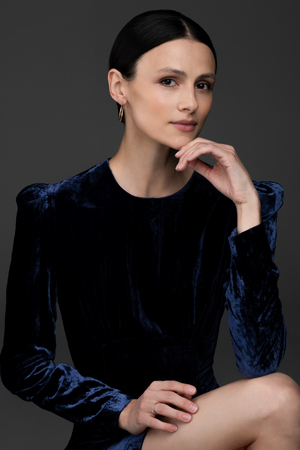
6 January 2026 |
That she is young, has exquisite feet, an ideal physique, is musically alert and technically assured... But Shapran seems to give each step, each action, an inner life that is revealed to us as she moves.
Financial Times
• Recipient of the Mikhailovsky Theatre Grand Prix (2009)
• Recipient of the audience award from Russia-Culture TV’s project Grand Ballet (2012)
Born in Leningrad (St Petersburg).
Graduated from the Vaganova Academy of Russian Ballet in 2011.
From 2011–2014 she was a soloist with the Stanislavsky and Nemirovich-Danchenko Moscow Music Theatre where her repertoire included lead roles in the ballets Giselle (Giselle), Don Quixote (Queen of the Dryads), The Nutcracker (Masha), Natalia Makarova's production of La Bayadère (Nikia), Pierre Lacotte’s staging of La Sylphide (The Sylph) and Roland Petit’s production of Coppélia (Swanilda).
From January to June 2014 she was a principal dancer at the Mikhailovsky Theatre where she performed lead roles in the ballets Giselle (Giselle, Mirtha), La Bayadère (Nikia), Le Corsaire (Medora) and Multiplicity. Forms of Silence and Emptiness.
Joined the Mariinsky Ballet in 2014.
Repertoire includes:
La Sylphide (the Sylph); choreography by August Bournonville, revised version by Elsa-Marianne von Rosen,
Giselle (Giselle); choreography by Jean Coralli, Jules Perrot and Marius Petipa,
La Fille du Pharaon (Fisherman’s wife); choreography by Marius Petipa reconstructed by Toni Candeloro,
Swan Lake (Odette-Odile); choreography by Marius Petipa and Lev Ivanov, revised version by Konstantin Sergeyev,
The Sleeping Beauty (La Fée des Lilas); choreography by Marius Petipa, revival of the 1890 production, staging by Sergei Vikharev,
The Sleeping Beauty (Lilac Fairy); choreography by Marius Petipa, revised version by Konstantin Sergeyev,
Raymonda (Clémence), choreography by Marius Petipa, revised version by Konstantin Sergeyev,
Le Corsaire (Medora); production by Pyotr Gusev after the composition and choreography by Marius Petipa,
Don Quixote (Street Dancer); choreography by Alexander Gorsky after motifs of the production by Marius Petipa,
Michel Fokine’s ballets Le Spectre de la rose (the Young Lady) and The Swan, Schéhérazade (Zobeide),
The Fountain of Bakhchisarai (Zarema); choreography by Rostislav Zakharov,
Romeo and Juliet (Juliet); choreography by Leonid Lavrovsky,
Spartacus (Phrygia); choreography by Leonid Yakobson,
George Balanchine's ballets Apollo (Terpsichore), Jewels (Diamonds), A Midsummer Night's Dream (Titania),
The Legend of Love (Mekhmeneh Bahnu, Shyrin); choreography by Yuri Grigorovich,
Le Jeune homme et la mort; choreography by Roland Petit,
In the Night; choreography by Jerome Robbins,
Marguerite and Armand (Marguerite); choreography by Frederick Ashton,
Le Parc (Soloist); choreography by Angelin Preljocaj,
Cinderella (Cinderella), Anna Karenina (Anna Karenina) and Concerto DSCH,
Adagio Hammerklavier; choreography by Hans van Manen,
Push Comes to Shove; choreography by Twyla Tharp,
The Nutcracker (Masha); production by Mihail Chemiakin, choreography by Kirill Simonov,
The Bronze Horseman (the Queen of the Ball); choreography by Rostislav Zakharov, Yuri Smekalov,
Yaroslavna. The Eclipse (Polovtsian Maiden); choreography by Vladimir Varnava,
Pavlovsk, The Fairy's Kiss (Fairy II); choreography by Maxim Petrov,
Violin Concerto No 2; choreography by Anton Pimonov,
The Four Seasons; choreography by Ilya Zhivoi,
The Seasons; choreography by Konstantin Keikhel;
12 (Reader), At the Wrong Time; choreography by Alexander Sergeev.
Repertoire also includes:
Divertimento; choreography by Dmitry Pimonov.
In December 2015 she made her debut at the Opéra de Paris as Nikia in the ballet La Bayadère, staged by Rudolf Nureyev.